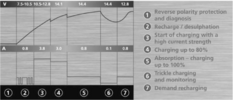The Eberspacher heater did have a low voltage cut out, I would think most do, as to battery voltage, I have in resent years had to revise my thoughts on damage to batteries due to over discharge. It does depend on type of lead acid, for a traction battery or absorbed glass mat or valve regulated lead acid they seem to survive deep cycling far better than the vehicle start battery, to get the high amps to start an engine yet keep the battery small, the way the spongy lead is held on the plates allows it to fall off with deep cycling, the leisure battery is a hybrid, not as bad as a vehicle start battery for loosing the material, but worse than a traction battery.
However load will drop the voltage on a traction battery much more than with a vehicle start battery, so where a battery needs to do both, a leisure battery needs to be 1.5 times the size of a vehicle start battery where used for duel tasks, like in a motor home.
So not seen a diesel heater run of a battery less than 90 Ah, in the main looking at 3 x 140 Ah batteries when used in a narrow boat, a forth 140 Ah being used to start the engine. And even then I know my son had problems keeping the heater running through the night.
In the main we over charge batteries to equalise the cells, and speed up charging time, where they are float charged we use around the 13.4 volt, but a vehicle is between 13.8 and 14.8 volt depending on the system used. The automatic chargers for AGM typically charge to 14.4 volt then switch off until battery voltage hits below 12.8 volt and then they turn back on, this is considered better than a float charge of 13.4 volt as it does equalise the cells.
Most manufacturers have the minimum no load voltage as 12.4 volt, under that returns are rejected, and the stage charges (some times called smart charges, use a pulse system to charge a battery under 10.5 volt, a typical charge graph

this charger is a problem if battery being used, as it will not return to full 3.8 amp once it passes that stage, it alternates between 0.8 and 0.1 in large battery selection and 0.1 and off in small battery selection, the latter Lidi charge does return to 3 amps. And I think the Ctek does return to full output.
As to batteries left to fully discharge, when my father-in-law died I found two stair lift batteries which had been abandoned some 6 months earlier, I had to cheat to charge them, by putting in parallel with a good battery, the charger set to small battery mode was put on the pair through an energy meter, it charged the good battery then switched off for 10 days, then started charging the abandoned battery as if some one had flicked a switch, this was unexpected, and after it had finished charging the 7 Ah battery seemed to be fully restored, this was a VRLA type, the second battery of the pair did the same, and I have found VRLA/AGM batteries do seem to recover if left on charge long enough and were OK to start with, leisure batteries also seem to recover, as do the old jell batteries used to heat the valves on old radios. But vehicle start batteries the success rate is a lot lower, when I studied at collage in the late 60's early 70's smart chargers were not around. We would have never dreamed of leaving a battery on charge for two weeks, the chargers back then would have fried the battery.
The problem I found with a caravan was volt drop in the cables from the car, so the battery could be 12.4 volt, but at the caravan under load it was below the cut out voltage of the inverter, at the 14 volt charge voltage the battery to battery inverter input voltage was high enough for it to run and charge the caravan battery, the whole idea of charging a caravan battery from the car has changed, we use to used split charging relays in the car, but modern cars turn off the charging when under power and only charge on over run, this is dangerous with split charging relays as they switch off and this disconnects the anti-snake device in the caravan, so now blocking diodes are used instead, although not a huge volt drop, there is some, so simply connection to caravan battery does not work, it needs a battery to battery charger or inverter, so caravan battery is stage charged. And ignition supply is not lost due to car saving energy by stopping the alternator charging.
So question is how long and what size is the cable used battery to heater? Is this causing the volt drop, what size battery is being used, 40 Ah is minimum size for a caravan "A721.55.3.2 Capacity" and I would say in the main smallest used is 90 Ah, I would use smaller I have two 35 Ah AGM batteries for the mobility scooter and likely they would be OK where there is normally a mains supply, but would need a smart charger so stop over charging.


